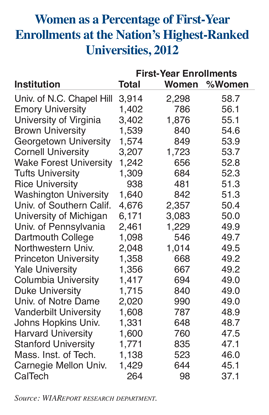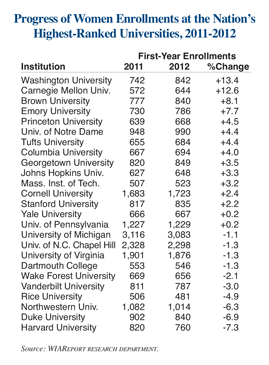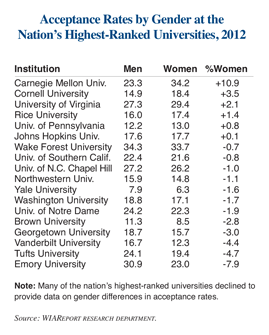First-Year Women at the Nation’s Leading Research Universities
Posted on Dec 13, 2012 | Comments 0
![]() For the second year in a row, WIAReport has surveyed the nation’s highest-ranking research universities to determine the percentage of women in this year’s entering classes. This year, for the first time, we also report on gender differences in acceptance rates at these schools and whether women have made gains in enrollments at these colleges compared to where they were a year ago.
For the second year in a row, WIAReport has surveyed the nation’s highest-ranking research universities to determine the percentage of women in this year’s entering classes. This year, for the first time, we also report on gender differences in acceptance rates at these schools and whether women have made gains in enrollments at these colleges compared to where they were a year ago.
Of the 27 high-ranking universities that responded to our survey, women were a majority of the entering students at 12 schools while there were more men than women in the entering classes at 15 universities. Last year, there were also 15 major research universities where men outnumbered women in the entering class.
There are wide variations in the percentage of women in the first-year classes at these highly rated universities. For the second year in a row, the highest percentage of women in the entering class among this large group of leading research universities is found at the University of North Carolina at Chapel Hill. There are 2,298 women among the 3,914 entering students at UNC this fall. Thus, women make up nearly 59 percent of all first-year students.
Emory University is second in this year’s survey with an entering class that is 56.1 percent female. As was the case last year, the University of Virginia had the third highest percentage of women in its entering class among this group of leading research universities. Ranking in fourth place overall and first among the eight Ivy League institutions is Brown University. Women make up 54.6 percent of all first-year students at Brown this fall.
At the other extreme, women make up only 37.1 percent of the entering students at the California Institute of Technology. Carnegie Mellon University in Pittsburgh and the Massachusetts Institute of Technology were also at the bottom. But this is hardly surprising considering that these three schools have large numbers of students in engineering and other STEM disciplines where historically women have been vastly underrepresented.
Since this is the second year of the WIAReport survey, we can compare last year’s results to the current data. Of the 25 leading universities for which we have data in both years, 15 schools show an increase in the number of women first-year students and 10 show a decline.
We find that the number of women in the entering class at Washington University in St. Louis is up 13.4 percent from a year ago. Carnegie Mellon University posted a 12.6 percent increase in women in its entering class this year. Brown University and Emory University both had gains of about 8 percent in the number of women in their entering classes.
In contrast, the number of entering women students at Harvard University is down more than 7 percent from a year ago. Northwestern University and Duke University also showed drops of more than 5 percent in first-year women students.
It is well known that nationwide women outpace men in college enrollments, graduation rates, and degrees earned. Because of a large and growing gender gap in enrollments at many colleges and universities, it has become easier for men to gain admission to some colleges and universities. It must be noted that just because men have a higher acceptance rate than women at a given institution does not necessarily mean that men have received an unfair admissions advantage. A particular college or university may simply have had an outstanding pool of male applicants in a given year.
We do note that many high-ranking universities are reluctant to report gender differences in acceptance rates. We will simply present the data and let readers make their own conclusions.
Of the 18 highly rated research universities that supplied data, we find that women were accepted at a higher rate than men at only six institutions. The greatest difference was at Carnegie Mellon University, which as stated is heavily focused on STEM disciplines. At this highly rated university, 34.2 percent of women were accepted for admission compared to only 23.3 percent of male applicants. Thus, there was a very large acceptance rate gap in favor of women of 10.9 percentage points.
The next highest acceptance rate gap in favor of women was 3.5 percentage points at Cornell University. The only other leading research universities where women were accepted at a higher rate than men were the University of Virginia, Rice University, the University of Pennsylvania, and Johns Hopkins University.
At the other end of the spectrum, Emory University in Atlanta, which ranks second in the percentage of women in its first-year class, had the highest gender gap in acceptance rate in favor of men. Emory accepted 30.9 percent of male applicants but only 23 percent of women applicants. At Vanderbilt University and Tufts University, the acceptance rate for men was more than 4 percentage points higher for men than it was for women.
Filed Under: Enrollments • Featured • Gender Gap











